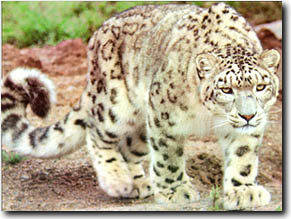 |
|
Wildlife in Ladakh Trekking above the tree line in the Himalayas is an experience easier felt than communicated. There is a crisp newness in the air.Despite bone-chilling cold and fatigue, the mind somehow feels scrubbed clean and with every step one celebrates the simple fact of being alive.Raptors, choughs and a host of other birds and insects serve as constant companions. The whistle of marmots and the buzz of bees are reminders of the throb of life which exists despite the visual bleakness of the surrounds. Thanks to the enlightened protection of the J&K Wildlife Department and the pioneering of the efforts of Dr. Joseph Fox who heads the Indo-US Snow Leopard Project, a stream of information has started pouring in about the natural history of this elusive predator. The fragilityof mountain eco-system is difficult to to comprehend. Humans can, at best, hazard intelligent guesses as to the checks and balances which come into play in maintaining a healthy mountain environment.
Our sophisticated equipment is wholly inadequate in accessing whether or not a habitat is thriving. To orient the visitors to the sanctuary, the authorities shall be setting up aNature Interpretation Center, which will house specimens, to familiarise tourists with the types of life forms found in the forest. The Center will possess an updated library, checklists of birds and animals present, visual aids and soon, a pre-recorded audio-visual programme on the natural heritage of Jammu and Kashmir. As mentioned earlier, it is not expected the task to be an easy one, but the rewards of such endeavours - the sight of healing forests – compensates for all kinds of hardships. Recognizing the immediate threat to the survival of the snow leopard in the wild, the Government of the United States Fish and Wildlife Services have agreed to a co-operative effort to develop a conservative programme for the snow leopard in Northern India. The Wildlife Institute of India, created in part to support research on threatened wildlife species of the sub-continent , the University of Washington, the Woodland Park Zoological Gardens and the International Snow Leopard Trust are other institutions participating in the project. Acting on a vote at the Fourth International Snow Leopard Symposium, the Government of India was asked to host the fifth International Snow Leopard Symposium. It would now be possible for representatives, in areas where the Snow Leopard occurs in the wild, to confer with experts from countries which have ezperience with captive breeding and other such programmes. The Fifth International Snow Leopard Symposium , which took place from October 13-15,1986, in srinagar, was attended by representatives from over 21 countries. Its basic purpose is to promote measures and exchange information which will help to ensure the perpetuation of viable breeding populations of the species. Besides the free flow of information about the status of the snow leopard in the wild, there are a number of related objectives that the Symposium seeks to meet: To provide a means for discussion on the management of the snow leopard in captivity; to inform and educate persons on the endangered status of the snow leopard and the importance of its relationship with other mountain species; to promote continued cultural and ecological research on alpine eco-systems; to develop an outline for a universally compatible information system, including a comprehensive annotated bibliography; to identify key education programmes and methods of disbursement and to identify the possibility of release programmes. An important part of the Symposium will be a discussion on the status and distribution of the snow leopard with regard to associate prey species in the animal’s natural habitat. And to identify a suitable site for carrying out an in-depth study on the ecology of the snow leopard. Only after such research has been undertaken, can vital habitats for the snow leopard be protected and management plans developed. The paucity of data on this animal can be attributed to the cat’s elusiveness and the harsh climate and rugged terrain in which it lives. The snow leopard inhabits the high mountains of Central Asia, and within India, is found along the northern border, in Arunachal Pradesh, Sikkim, Uttar Pradesh, Himachal Pradesh and Jammu and Kashmir.The Ladakh district of Jammu and Kashmir includes a large area of potential habitat and reports indicate that a relatively undistributed snow leopard population may exist in a few sites. Since the Ladakh area is known to support snow leopard populations, and some of the habitat is fairly accessible, this may prove to be a feasible study site for ecological investigation. The snow leopard is considered endangered in every region in which it is found. Three factors contribute towards a decline in its population.Firstly, the animal is hunted by the locals for its valuable pelt and also to protect livestock. Secondly, ungulate prey of the snow leopard, wild sheep and goats, have been reduced by hunting for human consumption and thirdly, domestic livestock has displaced wild ungulates from their grazing areas. If this trend continues, it is doubtful whether the snow leopard will survive, except in a few isolated areas or in captivity.
|
||||||||||||||||||||||||

